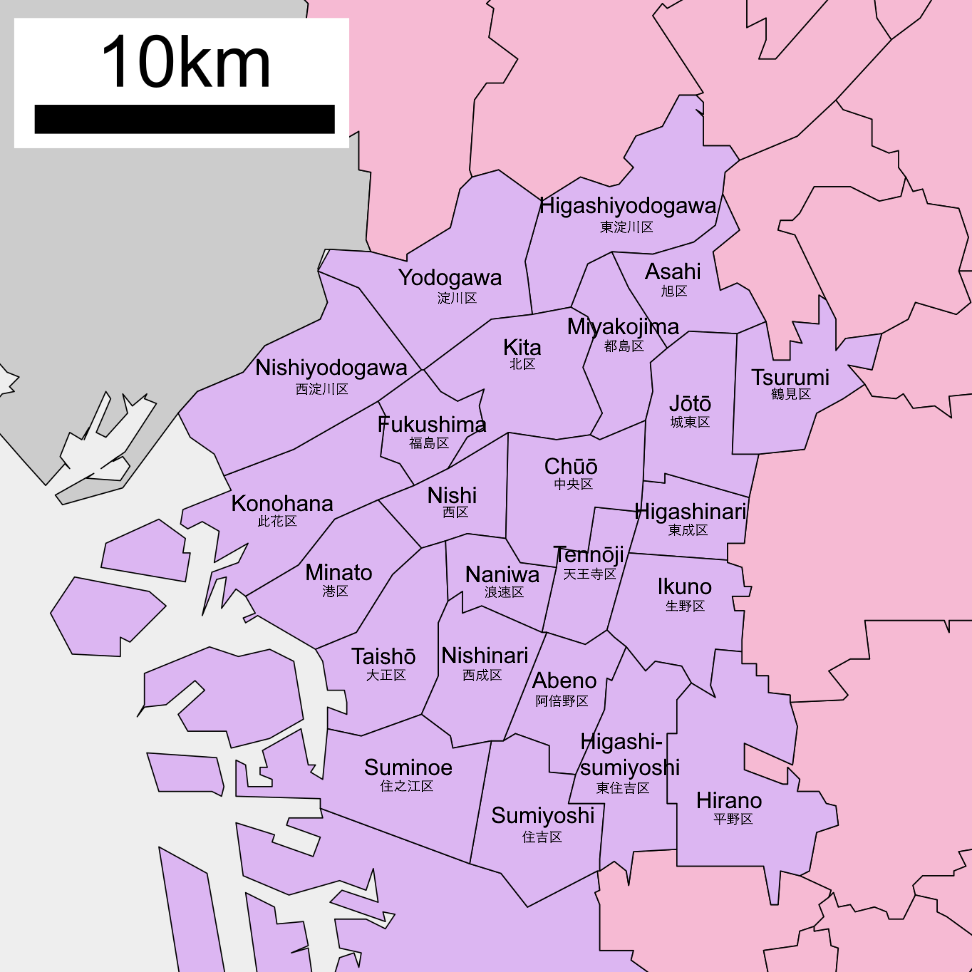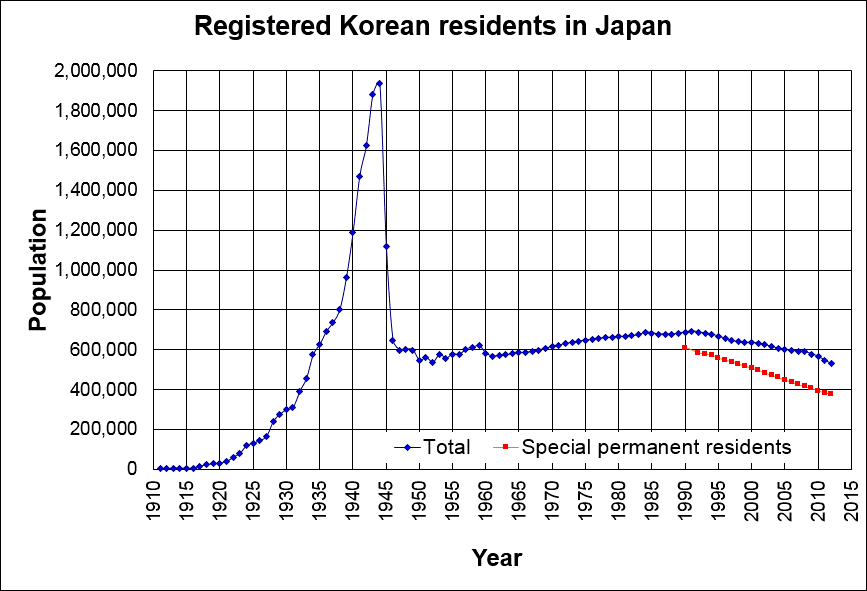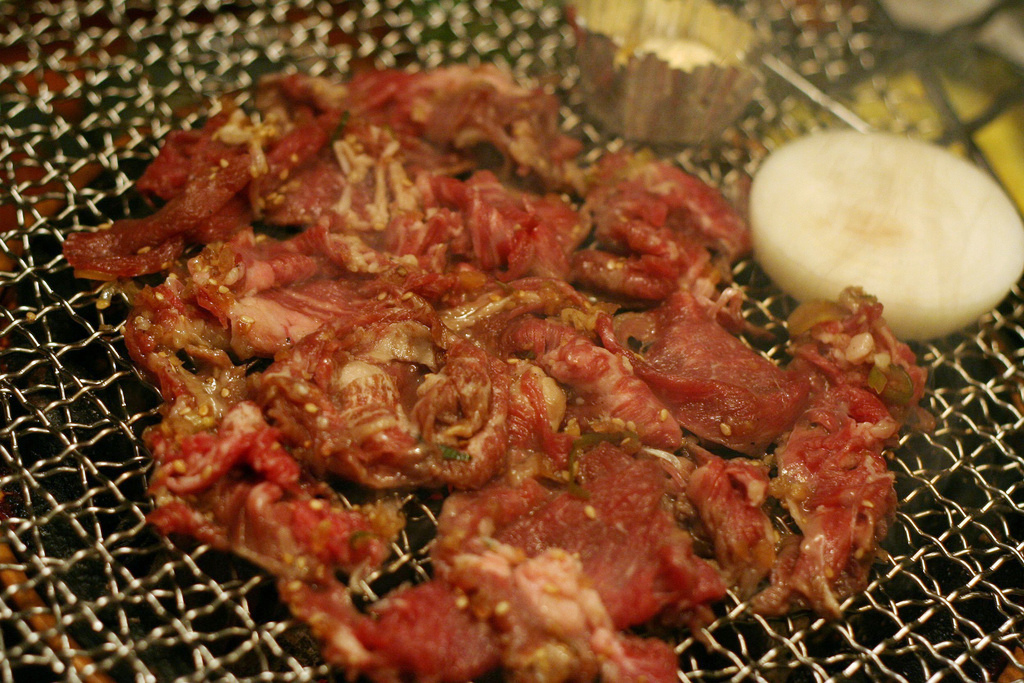|
Tsuruhashi Station
is a railway station complex in the Tsuruhashi district of Ikuno-ku and Tennoji-ku, Osaka, Japan. It is served by the JR West Osaka Loop Line, the Kintetsu Nara Line, and the Osaka Metro Sennichimae Line. Kintetsu Railway This station has a stationmaster and administrates itself and Imazato Station. Layout The station on the Kintetsu lines has two island platforms serving four tracks on the second level. The platforms enable passengers to change trains between the Nara Line and the Osaka Line (cross-platform interchange). Adjacent stations History The Kintetsu platform featured what was once the smallest FamilyMart store in Japan. It closed down in June 2022. West Japan Railway Company This station has a stationmaster and administrates Teradacho, Momodani, Tamatsukuri and Morinomiya stations. Layout The station on the Osaka Loop Line has two side platforms serving two tracks on the third floor, over the western side of the platforms and track ... [...More Info...] [...Related Items...] OR: [Wikipedia] [Google] [Baidu] |
Osaka
is a Cities designated by government ordinance of Japan, designated city in the Kansai region of Honshu in Japan. It is the capital of and most populous city in Osaka Prefecture, and the List of cities in Japan, third-most populous city in Japan, following the special wards of Tokyo and Yokohama. With a population of 2.7 million in the 2020 census, it is also the largest component of the Keihanshin, Keihanshin Metropolitan Area, which is the List of metropolitan areas in Japan, second-largest metropolitan area in Japan and the 10th-List of urban areas by population, largest urban area in the world with more than 19 million inhabitants. Ōsaka was traditionally considered Japan's economic hub. By the Kofun period (300–538) it had developed into an important regional port, and in the 7th and 8th centuries, it served briefly as the imperial capital. Osaka continued to flourish during the Edo period (1603–1867) and became known as a center of Japanese culture. Following the M ... [...More Info...] [...Related Items...] OR: [Wikipedia] [Google] [Baidu] |
Tennōji-ku, Osaka
is one of 24 wards of Japan, wards of Osaka, Japan. It is named after the ''Shitennō-ji'', the temple of the Four Heavenly Kings, which is located in the ward. General information Tennōji Station is the city's main southeastern rail terminal with Osaka Municipal Subway's Tennōji Station Midōsuji Line and Tanimachi Line, JR Tennōji as the terminus of the JR Hanwa Line (and a major stop on the Kyoto Line, Osaka Loop Line, Yamatoji Line and Kansai Airport Line) and the Kintetsu Abenobashi Station, directly across the street from Tennōji station is the terminus of the Minami Osaka Line. As a result of its being a major railway hub, it has become a major built up area in southern Osaka. The buildings around the station include, the Kintetsu department store, Mio, Station Plaza, and Hoop shopping malls, Apollo Movie Theater and Lucias shopping mall, as well as the more recent Q's Mall. In addition, there are several shopping streets in the area including Abenobashisuji. The Ki ... [...More Info...] [...Related Items...] OR: [Wikipedia] [Google] [Baidu] |
Railway Stations In Japan Opened In 1914
Rail transport (also known as train transport) is a means of transport using wheeled vehicles running in tracks, which usually consist of two parallel steel rails. Rail transport is one of the two primary means of land transport, next to road transport. It is used for about 8% of passenger and freight transport globally, thanks to its energy efficiency and potentially high speed.Rolling stock on rails generally encounters lower frictional resistance than rubber-tyred road vehicles, allowing rail cars to be coupled into longer trains. Power is usually provided by diesel or electric locomotives. While railway transport is capital-intensive and less flexible than road transport, it can carry heavy loads of passengers and cargo with greater energy efficiency and safety. Precursors of railways driven by human or animal power have existed since antiquity, but modern rail transport began with the invention of the steam locomotive in the United Kingdom at the beginning of the 19th ... [...More Info...] [...Related Items...] OR: [Wikipedia] [Google] [Baidu] |
Railway Stations In Japan Opened In 1932
Rail transport (also known as train transport) is a means of transport using wheeled vehicles running in railway track, tracks, which usually consist of two parallel steel railway track, rails. Rail transport is one of the two primary means of land transport, next to road transport. It is used for about 8% of passenger and rail freight transport, freight transport globally, thanks to its Energy efficiency in transport, energy efficiency and potentially high-speed rail, high speed.Rolling stock on rails generally encounters lower friction, frictional resistance than rubber-tyred road vehicles, allowing rail cars to be coupled into longer trains. Power is usually provided by Diesel locomotive, diesel or Electric locomotive, electric locomotives. While railway transport is capital intensity, capital-intensive and less flexible than road transport, it can carry heavy loads of passengers and cargo with greater energy efficiency and safety. Precursors of railways driven by human or an ... [...More Info...] [...Related Items...] OR: [Wikipedia] [Google] [Baidu] |
Railway Stations In Japan Opened In 1969
Rail transport (also known as train transport) is a means of transport using wheeled vehicles running in tracks, which usually consist of two parallel steel rails. Rail transport is one of the two primary means of land transport, next to road transport. It is used for about 8% of passenger and freight transport globally, thanks to its energy efficiency and potentially high speed.Rolling stock on rails generally encounters lower frictional resistance than rubber-tyred road vehicles, allowing rail cars to be coupled into longer trains. Power is usually provided by diesel or electric locomotives. While railway transport is capital-intensive and less flexible than road transport, it can carry heavy loads of passengers and cargo with greater energy efficiency and safety. Precursors of railways driven by human or animal power have existed since antiquity, but modern rail transport began with the invention of the steam locomotive in the United Kingdom at the beginning of the 19th c ... [...More Info...] [...Related Items...] OR: [Wikipedia] [Google] [Baidu] |
Osaka Metro Stations
is a Cities designated by government ordinance of Japan, designated city in the Kansai region of Honshu in Japan. It is the capital of and most populous city in Osaka Prefecture, and the List of cities in Japan, third-most populous city in Japan, following the special wards of Tokyo and Yokohama. With a population of 2.7 million in the 2020 census, it is also the largest component of the Keihanshin, Keihanshin Metropolitan Area, which is the List of metropolitan areas in Japan, second-largest metropolitan area in Japan and the 10th-List of urban areas by population, largest urban area in the world with more than 19 million inhabitants. Ōsaka was traditionally considered Japan's economic hub. By the Kofun period (300–538) it had developed into an important regional port, and in the 7th and 8th centuries, it served briefly as the imperial capital. Osaka continued to flourish during the Edo period (1603–1867) and became known as a center of Japanese culture. Following the M ... [...More Info...] [...Related Items...] OR: [Wikipedia] [Google] [Baidu] |
Osaka Municipal Transportation Bureau
Osaka Municipal Transportation Bureau (大阪市交通局, ''Ōsaka-shi Kōtsū-kyoku'') was the public department of transportation of the city of Osaka, Japan that existed from 1903 to 2018. It operated the municipal subway lines, the New Tram, and the city buses that have replaced the remaining lines of the municipal tram network. On April 1, 2018, the bureau was split into two private companies: Osaka Rapid Electric Tramway K.K. (known as Osaka Metro) and Osaka City Bus. Services provided *Municipal trams: 1903–1969 *City trolleybus A trolleybus (also known as trolley bus, trolley coach, trackless trolley, trackless tramin the 1910s and 1920sJoyce, J.; King, J. S.; and Newman, A. G. (1986). ''British Trolleybus Systems'', pp. 9, 12. London: Ian Allan Publishing. .or troll ...es: 1953–1970 * Municipal subway: 1933–2018 (8 lines; Surutto KANSAI Cards and IC cards ( PiTaPa and ICOCA) accepted) ** New Tram: 1981–2018 *City buses: 1927–2018 (103 regular bus routes, ... [...More Info...] [...Related Items...] OR: [Wikipedia] [Google] [Baidu] |
Zainichi Korean
() are ethnic Koreans who immigrated to Japan before 1945 and are citizens or permanent residents of Japan, or who are descendants of those immigrants. They are a group distinct from South Korean nationals who have immigrated to Japan since the end of World War II and the division of Korea. They currently constitute the third largest ethnic minority group in Japan after Chinese people in Japan, Chinese immigrants. Their population declined significantly due to death, returning to Korea, and assimilating into the general Japanese population. The majority of Koreans in Japan are , often known simply as , who are ethnic Korean permanent residents of Japan. The term Zainichi Korean refers only to long-term Korean residents of Japan who trace their roots to Korea under Japanese rule, distinguishing them from the later wave of Korean migrants who came mostly in the 1980s, and from pre-modern immigrants dating back to antiquity who constituted the biggest ancestral group of the Japan ... [...More Info...] [...Related Items...] OR: [Wikipedia] [Google] [Baidu] |
Kimchi
Kimchi (; ) is a traditional Korean side dish (''banchan'') consisting of salted and fermented vegetables, most often napa cabbage or Korean radish. A wide selection of seasonings are used, including '' gochugaru'' (Korean chili powder), spring onions, garlic, ginger, and '' jeotgal'' (salted seafood). Kimchi is also used in a variety of soups and stews. Kimchi is a staple food in Korean cuisine and is eaten as a side dish with almost every Korean meal. There are hundreds of different types of kimchi made with different vegetables as the main ingredients. Examples of variants include ''baechu-kimchi'', ''kkakdugi'', '' chonggak-kimchi'', and '' oi-sobagi''. Traditionally, winter kimchi, called '' gimjang'', was stored in large earthenware fermentation vessels, called '' onggi'', in the ground to prevent freezing during the winter months and to keep it cool enough to slow down the fermentation process during summer months. The process of making kimchi was called gimjan ... [...More Info...] [...Related Items...] OR: [Wikipedia] [Google] [Baidu] |
Bulgogi
Bulgogi ( , , ; , ) is a '' gui'' (Korean-style grilled or roasted dish) made of thin, marinated slices of meat, most commonly beef, grilled on a barbecue or on a stove-top griddle. It is also often stir-fried in a pan in home cooking. Sirloin and rib eye are frequently used cuts of beef for the dish. Bulgogi is a very popular dish in South Korea, where it can be found anywhere from upscale restaurants to local supermarkets as pan-ready kits. Etymology came from the Korean word ''bulgogi'' (), consisting of ''bul'' ("fire") and ''gogi'' ("meat"). The compound word is derived from the Pyongan dialect, as the dish itself is a delicacy of Pyongan Province, North Korea. The dish became popular in Seoul and other parts of South Korea, introduced by refugees from Pyongan. It was listed in the 1947 edition of the ''Dictionary of the Korean Language'' as meat grilled directly over a charcoal fire. In the '' Standard Korean Language Dictionary'' published by the National Insti ... [...More Info...] [...Related Items...] OR: [Wikipedia] [Google] [Baidu] |
Platform Screen Doors
Platform screen doors (PSDs), also known as platform edge doors (PEDs), are used at some train, rapid transit and people mover stations to separate the platform from train tracks, as well as on some bus rapid transit, tram and light rail systems. Primarily used for passenger safety, they are a relatively new addition to many metro systems around the world, some having been retrofitted to established systems. They are widely used in newer Asian and European metro systems, and Latin American bus rapid transit systems. History The idea of platform edge doors dates from as early as 1908, when Charles S. Shute of Boston was granted a patent for "Safety fence and gate for railway-platforms". The invention consisted of "a fence for railway platform edges", composed of a series of pickets bolted to the platform edge, and vertically movable pickets that could retract into a platform edge when there was a train in the station. In 1917, Carl Albert West was granted a patent for " ... [...More Info...] [...Related Items...] OR: [Wikipedia] [Google] [Baidu] |








